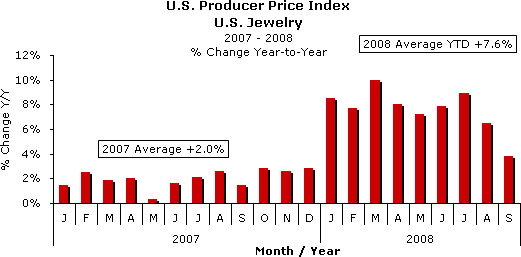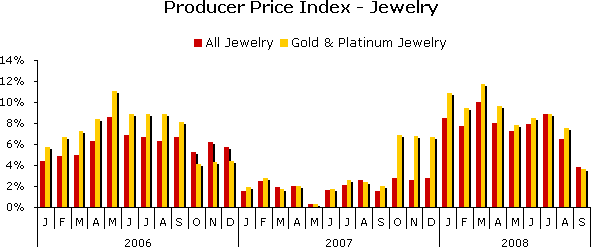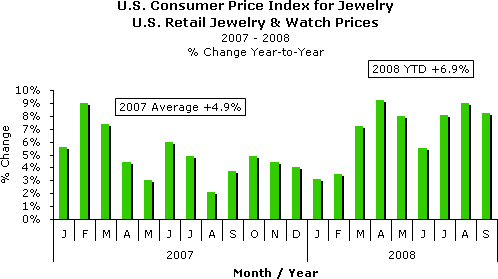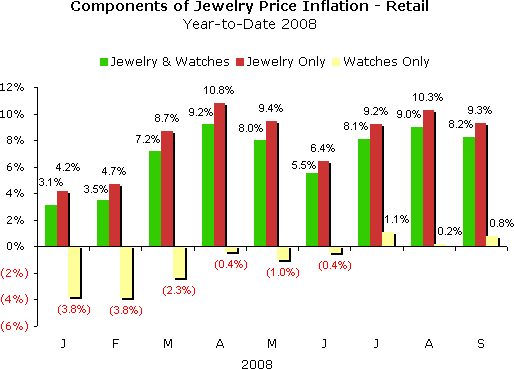IDEX Online Research: Jewelry Inflation Cools in September
October 28, 08
The flames of inflation in the jewelry industry have finally begun to fade as commodity prices have fallen in the past few months. Jewelry price increases at both the consumer level and the producer level moderated in September, according to the latest data from the U.S. Bureau of Labor Statistics. September’s inflation numbers are a reversal of the surging price increases which the industry has experienced for most of 2008.
Here’s the summary of inflation at the jewelry retail and supplier level for the month of September, as expressed as a percentage change year-over-year (September 2008 versus September 2007):
- Jewelry Producer Price Index +3.8%
- Jewelry & Watch Consumer Price Index +8.2%
- Jewelry CPI +9.3%
- Watch CPI +0.8%
The much lower Jewelry Producer Price Index (JPPI) is good news for jewelers, especially retailers. Many jewelers had raised prices earlier this year, but have been reluctant to continue to raise prices, especially in an environment of weakening demand, despite higher prices from their suppliers. Further, jewelers did not want to raise prices in the face of the upcoming holiday selling season when they generate about one-third of their annual sales. Jewelers’ holiday promotional brochures have been printed, and prices are fixed; additional price increases from their suppliers would have hurt their margins. Now, it appears that price pressure from jewelry suppliers may have abated, at least for the holiday selling season.
At the supplier level, many jewelry producers have found that they were unable to pass along to retailers the full amount of their cost increases. Thus, their margins were being squeezed significantly. With the moderation in jewelry price inflation – largely due to commodity prices which have declined – suppliers will be able to stabilize their prices and margins.
Commodity Prices Under Pressure
It is no surprise that jewelry price inflation was tamed in September. Gold and other precious metals prices have fallen; diamond prices have declined. As a result, jewelry manufacturing costs have declined, especially for goods with a large portion of their costs related to materials (large stones, heavy metal).
Will jewelry prices revert to a deflationary mode? For the ten-year period between 1996 and 2005, retail jewelry prices fell in the U.S. market each year by just a percent or two. Inflation reared its head only in the past three years.
Like the Federal Reserve tells the financial community, some inflation is healthy. Our sense is that price inflation at an annual rate of +2-3 percent is probably healthy for the jewelry industry. Persistent deflation is not good, nor is raging inflation.
Our Outlook
Earlier this year, we said that we did not believe that price inflation could continue at high single digit levels. For the year-to-date, retail jewelry prices are up 6.9 percent while jewelry producer prices are up 7.6 percent. We made our forecast based on declining precious metals prices late this summer; precious metals prices have been the primary driver of jewelry price inflation.
It now appears that jewelry price inflation could be headed lower; we may have seen the largest price increases of the year during the first half of 2008, though there could be some inflation volatility for short periods over the next couple of months as the market settles down and finds stability.
We continue to forecast both jewelry CPI and jewelry PPI to be about +7 percent for the full year of 2008, but our forecast could be reduced, perhaps significantly, depending on inflation trends in the final quarter of the year. At the retail level, the typical U.S. jeweler generates about 40 percent of their annual sales during the last calendar quarter of the year. If inflation at the retail level levels off, the full year average inflation rate will moderate. Whatever happens, though, we believe that the worst inflationary environment is over.
Jewelry Producer Price Index (JPPI) +3.8% in September
U.S. jewelry producer prices (JPPI) rose by a moderate 3.8 percent in September 2008, according to the U.S. Bureau of Labor Statistics (BLS). This was by far the smallest monthly gain this year, and reflects retreating precious metals prices.
There is still a backlog of costs in the distribution pipeline that suppliers need to pass on to their customers. But the good news is that the pressure is off – suppliers’ costs have begun to moderate, so they aren’t being forced to continue to raise prices in the face of a weakening environment of consumer demand. We believe that suppliers will likely hold off on any new price increases near term for two reasons: 1) jewelers simply won’t accept higher prices going into the holiday selling season; and 2) suppliers are “taking the temperature” of the current sales environment – if demand weakens, they will be much more reluctant to try to force their customers to accept higher prices for goods. Because the supplier community is so fragmented, no one has pricing power. We’ve already seen some panic pricing by suppliers who are trying to move goods – at a loss, if necessary – to raise cash. In that kind of environment, any supplier who tries to raise prices will lose business.
The following graph summarizes the monthly Jewelry Producer Price Index for inflation since the beginning of 2007. The percentage figures are based on year-to-year comparisons of the BLS Jewelry Producer Price Index.

Source: BLS
What is fueling this decelerating pace in the Jewelry Producer Price Index? Prices for both precious metal jewelry and gemstone jewelry have moderated. The graph below compares the JPPI (red bars) to inflation for precious metals (gold bars); gold is the primary driver of precious metals inflation. We note, however, that producer price inflation in September was well below the retail price inflation rate for the entire jewelry category. Earlier this year, producer prices in the precious metals category rose more than the corresponding retail prices. Now, retail prices are catching up, though we continue to believe that retail jewelry price inflation will moderate in the fourth quarter. However, these trends illustrate the lag effect – 3-5 months – between rising producer prices and the resultant rising retail prices.

Source: BLS
Jewelry Consumer Price Index (JCPI) +8.2 percent in September
U.S. jewelry consumer prices (JCPI) rose by 8.2 percent in August, as calculated by the BLS. After rising sharply in March, April, and May, jewelry price increases at the retail level moderated in June, but have re-accelerated in July and August. For the year-to-date, retail price inflation for jewelry in the U.S. market is running at an annual rate of +6.9 percent.
We believe that jewelry retail prices rose sharply early in the year as retailers repriced goods to reflect the pent-up inflation that was flowing through from the supplier level. Zale, Sterling (Kay) and others announced they were going to raise prices. As a result, most independent specialty jewelers also implemented price increases.
We think that June’s retail price inflation pause was either a statistical aberration or a momentary pause in inflation. Either way, jewelers continued to raise their prices in the face of sharply rising costs, as shown by the July and August data. September’s inflation rate, while down from prior levels, is still high by historic trends.
The graph below summarizes the percentage change in retail prices of jewelry and watches by month on a year-to-year basis since 2007. The percentage change is based on a comparison to the same month a year ago (September 2008 versus September 2007).

Source: BLS
The components of jewelry and watch price inflation at the retail level reflect a dichotomy in price increases. Jewelry retail prices have been up consistently during the first half of 2008, but watch retail prices have shown virtually no price inflation this year, though they have risen almost imperceptibly in the past three months. We are a bit surprised that watch price inflation has lagged. Why? There are two key reasons: 1) mechanical watch mechanisms from Switzerland have been in short supply due to manufacturing capacity constraints; and 2) demand for high-end watches and branded watches has been strong, according to retail jewelers. However, because of the consistency of the BLS inflation numbers, we are inclined to believe that watch prices were down very slightly at retail, at least during the first half of the year.
The graph below illustrates the JPPI consisting of both jewelry and watch prices (green bars), jewelry prices only (red bars), and watch prices (yellow bars).

Source: BLS
Outlook: Inflation Will Moderate in the Fourth Quarter
Our forecast calls for both jewelry consumer prices and jewelry producer prices to rise by about 7 percent in 2008. While we are not ready to revise this forecast, it is likely that we will cut our projections during the fourth quarter, especially if the jewelry inflation rate continues to moderate.